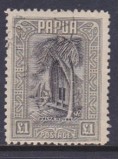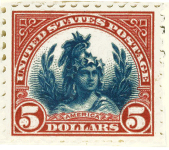
Discussion - Member to Member Sales - Research Center

Discussion - Member to Member Sales - Research Center



Login to Like
this post

09:08:52am
Picture is not clear enough. Upload a picture that is 800 pixels wide.
Roy

Login to Like
this post


Login to Like
this post

06:02:04pm
It looks like a currency conversion, but it is not into Sterling.
Currency conversions of that period of time can be closely estimated by studying the weights and metal content of silver and gold coins of the time, since any misalignment would result in a flow of coins from one country to another.
The German Mark of 1873 was a 5.55 gm coin of .900 fine silver with a silver content of .1606 oz actual silver weight (ASW).
This was almost exactly equivalent to the British shilling, which was a 5.655 gm coin of .925 fine silver with ASW of .1682.
Since there are 20 shillings to the Pound, these numbers imply an exchange rate of approximately 20 Marks per Pound Sterling (plus or minus about 5%).
Therefore 38 Marks would buy slightly less than £2.
Note that the receiving station appears to be Zwickau. This is in Saxony. Southern Germany used a three-tier currency until unification with the rest of Germany, and I am sure it was still prevalent only 3 years after that happened in 1870.
10 pfennig = 1 Neu-Groschen
30 ng = 1 Thaler
Saxony minted a 1 Thaler coin in 1871 of .5360 ASW, or the equivalent of 3.34 Marks coins.
Applying this exchange rate to 38.47 Marks returns 11.5 Thaler. This appears to me close enough to the 16 Thaler 13 Neu-Groschen 5 pfennig that I believe this has been translated to. The difference between the 11 Thaler calculated and the 16 Thaler could be explained by a depreciation of the Thaler currency relative to the German currency a short time after German unification and after the Franco-Prussian war.
So, the short answer is that I believe the currency is Saxony's Thaler / Neu-Groschen / Pfennige.
Roy

1 Member
likes this post.
Login to Like.
Your answer seems totally correct. Thanks.

Login to Like
this post
Here's my 2 thalers ...
I confess to being no expert on this subject, but just looking at the document, wasn't the money paid in Arnstadt(?). If this is so the vereinthaler was at an official exchange of 3 marks per all the way up to whenever it was demonetarized in 1908 or so. The 38.47 M paid out in Zwichau would have been a conversion from whatever was paid in and not the currency of saxony. The official conversion rates from all the various states were officially fixed as I understand it. There were some fees related to these conversions to gold marks from the various silver currencies as well, but as they were all fixed by decree depreciation should not have anything to do with it. The mark was only first issued in 1873.
Obviously 3 times 16 is not 38 so there must be other factors or its not arnstadt but Looking at the various official rates I could not see any that would work out precisely.
I think the first thing to establish is what the actual issuing location was as that will establish the official exchange. The exchange appears to be about 2.4

Login to Like
this post
Oke I have looked into the history of ARNSTADT and Found the following :
(be prepared for your math !!!)
The NeuGroschen was introduced in 1858 in the Kingdom of Saxony and in some Thuringian states.
Old currency:
1 thaler = 24 groschen
1 Groschen = 12 pfennigs
New currency:
1 taler = 30 NeuGroschen
1 NeuGroschen = 10 pfennig
One gold mark was received for 10 NeuGroschen
Gold course in January 1861
1 Friedrichd’or = 5 Thlr 20 Sgr.
1 Louisd’or = 5 Thlr. 13 Sgr 6 Pf.
1 Kaiserl. Russian halber Imperial = 5 thlr. 13 Sgr.
1 dukaten = 3 thl. 4 Sgr.
1 goldkrone = 9 thlr. 3 Sgr. 6 Pf.
1 Dutch 10 fl. Piece = 5 Thlr. 14 Sgr.
1 20 Franc piece = 5 Thlr. 8 Sgr. 9 Pf.
Before the Reichsmark was introduced, the following values applied:
1 thaler = 30 silber groschen
1 silber groschen = 12 pfennig
1 Gulden = 21 groschen = 1 fl. (Florin)
1 Groschen = 12 pfennige
Conversion rate when the Reichsmark calculation was introduced on January 1, 1875
1 thaler = 3 marks
1 guilder in southern German currency = 1 5/7 mark
1 Mark Lübeckian or Hamburg Courant currency = 1 1/5 Mark
1/12 thaler piece = 25 pfennig
1/15 thaler piece = 20 pfennig
1/30 thaler piece = 10 pfennig
½ Groschen stuck = 5 pfennig
1/5 Groschen stuck = 2 pfennig
1/10 and 1/12 groschenstuck = 1 pfennig

HOPE YOU CAN READ THE CONVERSION TABLE
Have fun with the calculations...............

Login to Like
this post
IMHO this is a conversion between Gulden and Thaler. 28 (not 38, compare with the "3" in "13") Gulden 47 Kreuzer correspond to 16 Thaler 13 Neugroschen 5.14... (Prussian) Pfennig (or 4,28... Saxon Pfennig). Apparently they rounded up. Remember that 60 Kreuzer make 1 Gulden, and 7 Gulden = 4 Thaler.
-jmh

1 Member
likes this post.
Login to Like.
AND WE HAVE A WINNER.............. JMH67 !!!
I too was under the assumption that it was 38 ...

Login to Like
this post
05:51:43pm
The money is expressed in two values. I Think they're Marks/Pfennige and Pounds Stirling, but am uncertain. Help?


Login to Like
this post
BuckaCover.com - 80,000 covers priced 60c to $1.50 - Easy browsing 300 categories
14 Sep 2019
09:08:52am
re: German Postal Money Order 1873
Picture is not clear enough. Upload a picture that is 800 pixels wide.
Roy

Login to Like
this post
BuckaCover.com - 80,000 covers priced 60c to $1.50 - Easy browsing 300 categories
14 Sep 2019
06:02:04pm
re: German Postal Money Order 1873
It looks like a currency conversion, but it is not into Sterling.
Currency conversions of that period of time can be closely estimated by studying the weights and metal content of silver and gold coins of the time, since any misalignment would result in a flow of coins from one country to another.
The German Mark of 1873 was a 5.55 gm coin of .900 fine silver with a silver content of .1606 oz actual silver weight (ASW).
This was almost exactly equivalent to the British shilling, which was a 5.655 gm coin of .925 fine silver with ASW of .1682.
Since there are 20 shillings to the Pound, these numbers imply an exchange rate of approximately 20 Marks per Pound Sterling (plus or minus about 5%).
Therefore 38 Marks would buy slightly less than £2.
Note that the receiving station appears to be Zwickau. This is in Saxony. Southern Germany used a three-tier currency until unification with the rest of Germany, and I am sure it was still prevalent only 3 years after that happened in 1870.
10 pfennig = 1 Neu-Groschen
30 ng = 1 Thaler
Saxony minted a 1 Thaler coin in 1871 of .5360 ASW, or the equivalent of 3.34 Marks coins.
Applying this exchange rate to 38.47 Marks returns 11.5 Thaler. This appears to me close enough to the 16 Thaler 13 Neu-Groschen 5 pfennig that I believe this has been translated to. The difference between the 11 Thaler calculated and the 16 Thaler could be explained by a depreciation of the Thaler currency relative to the German currency a short time after German unification and after the Franco-Prussian war.
So, the short answer is that I believe the currency is Saxony's Thaler / Neu-Groschen / Pfennige.
Roy

1 Member
likes this post.
Login to Like.
08:12:07pm
re: German Postal Money Order 1873
Your answer seems totally correct. Thanks.

Login to Like
this post
06:11:22pm
re: German Postal Money Order 1873
Here's my 2 thalers ...
I confess to being no expert on this subject, but just looking at the document, wasn't the money paid in Arnstadt(?). If this is so the vereinthaler was at an official exchange of 3 marks per all the way up to whenever it was demonetarized in 1908 or so. The 38.47 M paid out in Zwichau would have been a conversion from whatever was paid in and not the currency of saxony. The official conversion rates from all the various states were officially fixed as I understand it. There were some fees related to these conversions to gold marks from the various silver currencies as well, but as they were all fixed by decree depreciation should not have anything to do with it. The mark was only first issued in 1873.
Obviously 3 times 16 is not 38 so there must be other factors or its not arnstadt but Looking at the various official rates I could not see any that would work out precisely.
I think the first thing to establish is what the actual issuing location was as that will establish the official exchange. The exchange appears to be about 2.4

Login to Like
this post

re: German Postal Money Order 1873
Oke I have looked into the history of ARNSTADT and Found the following :
(be prepared for your math !!!)
The NeuGroschen was introduced in 1858 in the Kingdom of Saxony and in some Thuringian states.
Old currency:
1 thaler = 24 groschen
1 Groschen = 12 pfennigs
New currency:
1 taler = 30 NeuGroschen
1 NeuGroschen = 10 pfennig
One gold mark was received for 10 NeuGroschen
Gold course in January 1861
1 Friedrichd’or = 5 Thlr 20 Sgr.
1 Louisd’or = 5 Thlr. 13 Sgr 6 Pf.
1 Kaiserl. Russian halber Imperial = 5 thlr. 13 Sgr.
1 dukaten = 3 thl. 4 Sgr.
1 goldkrone = 9 thlr. 3 Sgr. 6 Pf.
1 Dutch 10 fl. Piece = 5 Thlr. 14 Sgr.
1 20 Franc piece = 5 Thlr. 8 Sgr. 9 Pf.
Before the Reichsmark was introduced, the following values applied:
1 thaler = 30 silber groschen
1 silber groschen = 12 pfennig
1 Gulden = 21 groschen = 1 fl. (Florin)
1 Groschen = 12 pfennige
Conversion rate when the Reichsmark calculation was introduced on January 1, 1875
1 thaler = 3 marks
1 guilder in southern German currency = 1 5/7 mark
1 Mark Lübeckian or Hamburg Courant currency = 1 1/5 Mark
1/12 thaler piece = 25 pfennig
1/15 thaler piece = 20 pfennig
1/30 thaler piece = 10 pfennig
½ Groschen stuck = 5 pfennig
1/5 Groschen stuck = 2 pfennig
1/10 and 1/12 groschenstuck = 1 pfennig

HOPE YOU CAN READ THE CONVERSION TABLE
Have fun with the calculations...............

Login to Like
this post

re: German Postal Money Order 1873
IMHO this is a conversion between Gulden and Thaler. 28 (not 38, compare with the "3" in "13") Gulden 47 Kreuzer correspond to 16 Thaler 13 Neugroschen 5.14... (Prussian) Pfennig (or 4,28... Saxon Pfennig). Apparently they rounded up. Remember that 60 Kreuzer make 1 Gulden, and 7 Gulden = 4 Thaler.
-jmh

1 Member
likes this post.
Login to Like.

re: German Postal Money Order 1873
AND WE HAVE A WINNER.............. JMH67 !!!
I too was under the assumption that it was 38 ...

Login to Like
this post

